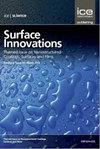以大黄为基础的天然染料对羊毛织物的微波辅助可持续着色
IF 3.5
4区 材料科学
Q3 CHEMISTRY, PHYSICAL
引用次数: 6
摘要
在现代染厂中使用天然着色剂是一种潜在的绿色化学理念,应得到广泛推广,以尽量减少羊毛染色对某些有害和不可生物降解的合成着色剂的依赖。本研究旨在探讨大黄提取物是否可作为天然染料替代合成染料用于羊毛染色。采用微波处理技术对羊毛织物进行染色。通过结合几种媒染剂,创造了不同色调和色调的令人惊叹的色调。对比评价了各种化学媒染剂(铝盐、铁盐、单宁酸、酒石膏)和生物媒染剂(石榴提取物、松子壳提取物)对染色羊毛样品特性的影响,为每种应用选择最佳媒染剂。结果表明,与金属媒染剂相比,生物媒染剂处理后的羊毛织物色牢度值为4/5 ~ 5,色强值约为10 ~ 20。扫描电子显微镜(SEM)照片和傅里叶变换红外光谱(FT-IR)分析揭示了辐照和未辐照羊毛织物之间的差异。由于毫瓦射线和生物媒染剂与毫瓦处理羊毛织物时具有生物相容性和无毒性,并且具有较高的色牢度和色强性能,因此鼓励在羊毛织物的自然着色中使用毫瓦射线和生物媒染剂。因此,天然提取的大黄染料可以替代合成染料用于纺织工业中羊毛织物的染色,因为它们具有环境问题。本文章由计算机程序翻译,如有差异,请以英文原文为准。
Microwave-assisted sustainable coloration of wool fabric using Rheum Emodi based natural dye
The use of natural colorants in modern dye factories is a potential green chemistry idea that should be widely promoted in order to minimize the wool dyeing’s dependency on some hazardous and non-biodegradable synthetic colors. In this study, an effort was undertaken to see if Rheum Emodi (Rhubarb) extract might be used as a natural dye for wool dyeing for the replacement of synthetic dyes. The dyeing of wool fabric was carried out using microwave (MW) rays’ treatment. By combining several mordants, a stunning color pallet of shades of varying hue and tone was created. Comparative evaluation of the effects of various chemical mordants (aluminum salt, iron salt, tannic acid, and cream of tartar) and bio mordants (pomegranate extract, and pine nut hull extract) on the characteristics of dyed wool samples was carried out to choose the best mordant for each application. It was found that MW treated wool fabric using bio mordant shown higher color fastness value of 4/5 to 5 and color strength value of approximately 10 to 20 rather than using metallic mordant. Scanning electron microscopy (SEM) photographs and Fourier transform infrared spectroscopy (FT-IR) analyses revealed the difference between irradiated and un-irradiated wool fabric. The employment of MW rays and bio-mordants in the natural coloring of wool fabric is encouraged due to their biocompatibility and non-toxicity when combined with MW treatment of wool fabric, as well as their high color fastness and color strength performances. As a result, the naturally extracted dyes from rhubarb can be the replacement of synthetic dyes for the coloration of wool fabric in the textile industry due to their environmental issues.
求助全文
通过发布文献求助,成功后即可免费获取论文全文。
去求助
来源期刊

Surface Innovations
CHEMISTRY, PHYSICALMATERIALS SCIENCE, COAT-MATERIALS SCIENCE, COATINGS & FILMS
CiteScore
5.80
自引率
22.90%
发文量
66
期刊介绍:
The material innovations on surfaces, combined with understanding and manipulation of physics and chemistry of functional surfaces and coatings, have exploded in the past decade at an incredibly rapid pace.
Superhydrophobicity, superhydrophlicity, self-cleaning, self-healing, anti-fouling, anti-bacterial, etc., have become important fundamental topics of surface science research community driven by curiosity of physics, chemistry, and biology of interaction phenomenon at surfaces and their enormous potential in practical applications. Materials having controlled-functionality surfaces and coatings are important to the manufacturing of new products for environmental control, liquid manipulation, nanotechnological advances, biomedical engineering, pharmacy, biotechnology, and many others, and are part of the most promising technological innovations of the twenty-first century.
 求助内容:
求助内容: 应助结果提醒方式:
应助结果提醒方式:


